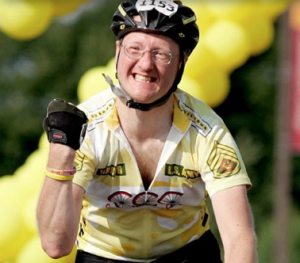“My Voice” by Scott Joy

Scott Joy - 'Survivor'
One spring night, I was shocked to find my right testicle was twice normal size. My doctor diagnosed it as a hydrocele. When it kept getting larger, I was referred to a urologist. On June 5, 2003, I had surgery to remove the testicle, now containing a 9 cm tumor.
I had already tried to memorize the Testicular Cancer Resource Center and introduced myself to the TC-NET mailing list. I was intellectually prepared when the news came: “It’s cancer.” I finished the conversation calmly and set the phone back on the hook. Seconds later, a storm built up inside me, and I burst out sobbing. My wife ran up the stairs as I worried aloud, “How could I do this to you?”
I have a life-altering disease.
A friend asked if I was planning to follow up my testicular cancer diagnosis by riding in the Tour de France. Google clued me in and delivered me to the Lance Armstrong Foundation’s website. “Knowledge is power. Attitude is everything.” I discovered “the obligation of the cured.” I read It’s Not About the Bike, which filled me with new hope.
My blood test results returned to normal, and CT scans showed no sign of spread. My doctors laid out the options and agreed that surveillance was a reasonable choice. I’d avoid retroperitoneal lymph node dissection (RPLND) and save chemotherapy in case of recurrence. We scheduled a series of monthly appointments for blood tests and chest x-rays.
Two things happened that summer that changed my life. The LAF website’s invitation to join the Peloton Project led me to take my mountain bike out of storage and start putting in more miles than I had ever dreamed, and a small Internet support forum I had joined asked if I would become an administrator.
I told my wife, “I think I need to go to Austin and ride 100 miles on a bike.”
“You… what?” she answered.
An inexperienced fundraiser, I was drawn to the mission of the Lance Armstrong Foundation and so grateful for its effect on me, it was easy to ask people to support the cause. I bought a Trek road bicycle and rode my first metric century, 62 miles, in a local organized cycling event as practice for what I knew was my inevitable trip to Texas.
I have a cause.
In May 2004, the LIVESTRONG wristband was launched, and I have worn one ever since. In July, I joined the group Cyclists Combating Cancer. That October, I took my bike to Austin, met amazing role models face to face, and completed the 100-mile Ride for the Roses course.
I’m part of a community.
Two years into surveillance, my CT scan indicated a recurrence, and I had laparoscopic RPLND surgery in June 2005. I was able to avoid chemotherapy, but a side effect after surgery called chylous ascites made my abdomen fill with lymphatic fluid like a water balloon, kept me out of work for three months, landed me in the emergency room with sepsis, and forced me to endure seven weeks with no food by mouth. I insisted I would keep my commitment to the Ride for the Roses for a second year, and fortunately my condition resolved just in time for that October trip. My wife and I traveled to Austin together, and I rode the 25-mile route, scrawny but determined.
Since then, I’ve remained cancer free, but my life has not. Close to home and around the globe, family, friends, neighbors, and colleagues have had other cancers: brain, breast, colon, kidney, lymphoma, pancreatic, skin, throat, thyroid, and on and on. Cancer is relentlessly unfair. Attacking the disease isn’t sufficient; people need to heal.
Every day, through the TC-Cancer support forum, Cyclists Combating Cancer, and the Lance Armstrong Foundation, I’m connected. I’ve met many instant friends, who understand. I’ve raised $75,000 and ridden hundreds of miles for the fight against cancer. I’ve advocated on Capitol Hill and in my community and accepted every call to volunteer I possibly can.
I can’t stand by and watch. I need to help.
I’m a survivor.


